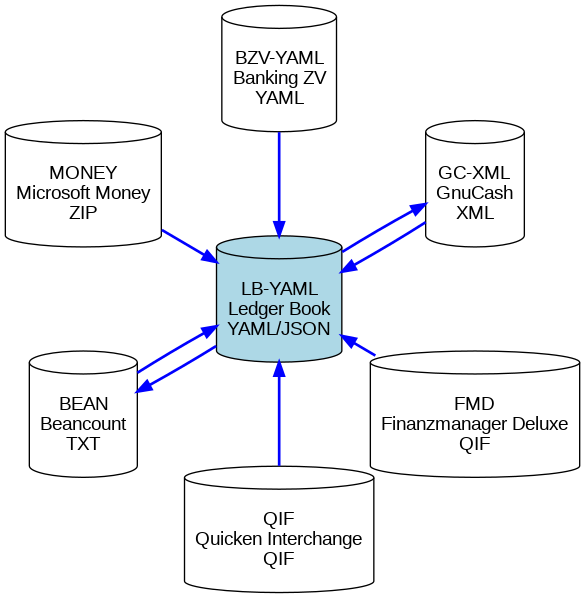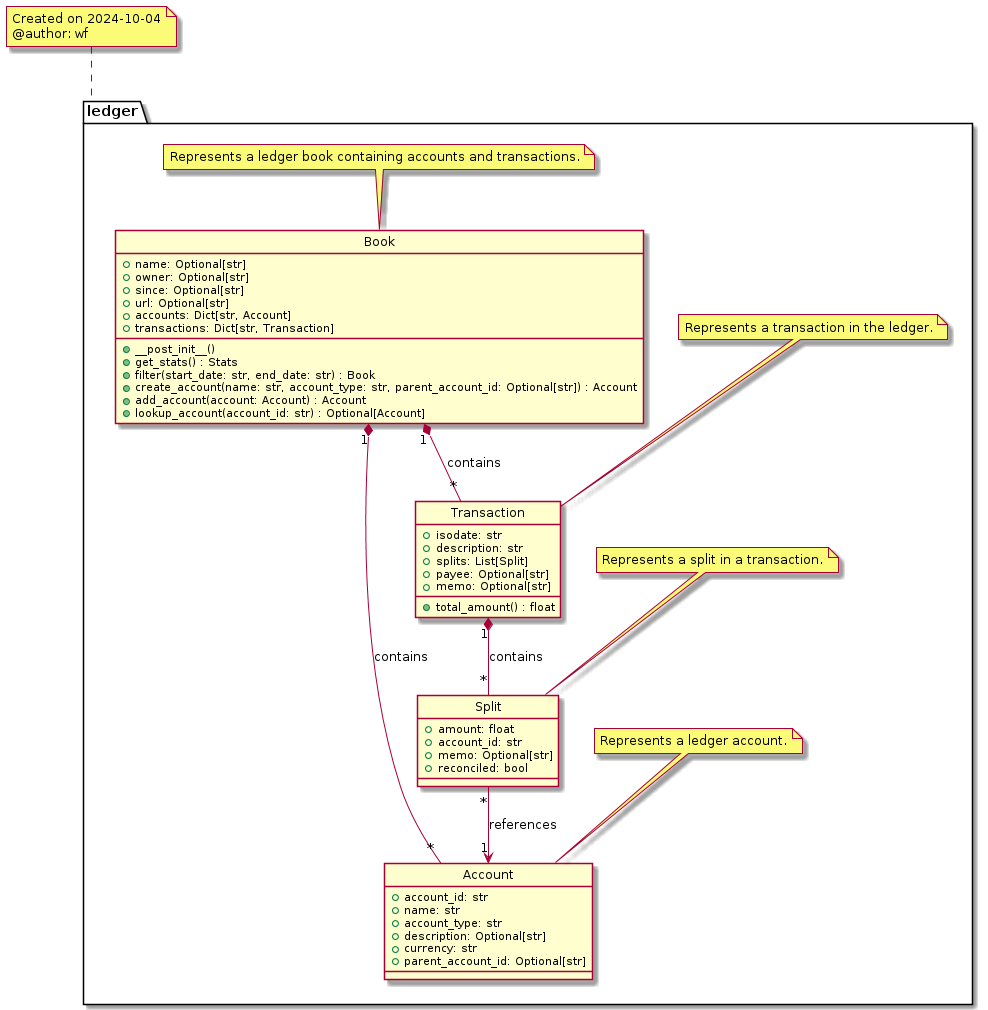Difference between revisions of "Pynomina"
| Line 7: | Line 7: | ||
|title=pynomina | |title=pynomina | ||
|url=https://github.com/WolfgangFahl/pynomina | |url=https://github.com/WolfgangFahl/pynomina | ||
| − | |version=0.0. | + | |version=0.0.5 |
|description=personal finance tool | |description=personal finance tool | ||
| − | |date=2024-10- | + | |date=2024-10-10 |
|since=2024-10-06 | |since=2024-10-06 | ||
}} | }} | ||
Revision as of 06:48, 10 October 2024
OsProject
| OsProject | |
|---|---|
| id | pynomina |
| state | active |
| owner | WolfgangFahl |
| title | pynomina |
| url | https://github.com/WolfgangFahl/pynomina |
| version | 0.0.5 |
| description | personal finance tool |
| date | 2024-10-10 |
| since | 2024-10-06 |
| until | |
Demo
Introduction
pynomina is a personal finance tool designed to provide a flexible and enduring solution for managing financial records from diverse personal accounting tool sources. It aims to address the challenges of data conversion between different accounting software and ensure long-term readability of financial data. There is only limited support for the actual accounting tasks - this can be done much better by existing commercial and open source solutions. pynomina aims to give you the long-term freedom of choice between tools.
Motivation
In the past decades the author used different personal accounting tools:
The pain the conversion between those tools created was finally big enough to do something about it.
Goals
- use a computer and human-readable ledger format that is ready to survive decades
- convert from and to the formats of the tool of choice
- allow for simple sanity checks and reports
- allow for systematic tidy up
- allow for integration into a larger organizational knowledge graph
Hub & Spoke Conversion
The pyNomina tool follows a Hub and Spoke model for conversion between different personal accounting file formats. The Ledger Book (YAML/JSON) format acts as the hub, with each supported format serving as a spoke. This setup simplifies conversions by allowing data to be transformed from any spoke to the hub and then to any other spoke format.

Supported Formats
| Format | Type | Description | Wikidata Entry |
|---|---|---|---|
| Ledger Book YAML/JSON | Hub | Main format of pyNomina for converting between formats. | Ledger Book |
| Beancount | Spoke | A plaintext accounting format. | Beancount |
| GnuCash XML | Spoke | An XML-based format used by GnuCash. | GnuCash |
| Microsoft Money | Spoke | Zip File exported with mny_export script using mdb-tools | Microsoft Money |
| Finanzmanager Deluxe (QIF) | Spoke | A variant of QIF used by Finanzmanager Deluxe. | Finanzmanager Deluxe |
| Quicken Interchange Format | Spoke | Quicken Interchange Format (QIF) | Quicken |
| pyNomina Banking ZV YAML | Spoke | A format for exporting banking data in YAML or JSON. | Banking ZV |
Installation
pip install pynomina
# alternatively if your pip is not a python3 pip
pip3 install pynomina
# local install from source directory of pynomina
pip install .
upgrade
pip install pynomina -U
# alternatively if your pip is not a python3 pip
pip3 install pynomina -U
tickets
Testing
The testcases are python unittest modules see https://github.com/WolfgangFahl/pynomina/tree/main/tests. These tests are run as part of the continuous integration github actions To run the tests manually there is a "test" script in the scripts directory:
scripts/test
Starting test test_read_bzv, debug=True ...
# Accounts: 3
# Transactions: 2
Date Range: 2024-10-06 to 2024-10-06
# Categories: 1
# Currencies: EUR: 2
Other Details:
name: expenses2024
owner: John Doe
test test_read_bzv, debug=True took 0.0 s
.Starting test test_conversions, debug=True ...
Converting Ledger Book None to GC-XML
...
Ran 17 tests in 4.518s
OK
see also https://github.com/WolfgangFahl/pynomina/issues/3
Ledger Book
The pynomina Ledger Book model consists of four main classes:
- Book
- Account
- Transaction
- Split
These are the necessary classes which work together to represent a comprehensive financial ledger records.
Class Structure

Book
The Book class represents the main container for all financial data. It includes:
- Basic information: name, owner, creation date, and source URL
- Collections of accounts and transactions
- Methods for managing accounts and transactions, including:
- get_stats(): Retrieves statistics about the book
- filter(): Filters transactions by date range
- create_account(): Creates a new account
- add_account(): Adds an account to the book
- lookup_account(): Finds an account by ID
Account
The Account class represents a hierarchy of individual financial accounts within the ledger. It includes:
- account_id: Unique identifier for the account
- name: Human-readable account name
- account_type: Type of account (e.g., EXPENSE, INCOME)
- description: Optional account description
- currency: Account currency (default: EUR)
- parent_account_id: Optional parent account for hierarchical structure
Transaction
The Transaction class represents individual financial transactions. It includes:
- isodate: Date of the transaction in International Standards Organization date format yyyy-mm-dd
- description: Description of the transaction
- splits: List of Split objects representing the movement of money
- payee: Optional payee information
- memo: Optional additional notes
- total_amount(): Method to calculate the total transaction amount
Split
The Split class represents the individual components of a transaction, showing how money moves between accounts. It includes:
- amount: The amount of money involved in the split
- account_id: The account associated with this part of the transaction
- memo: Optional notes for this split
- reconciled: Boolean indicating if the split has been reconciled
Example Data
Here's an example of how the ledger model is used in practice:
Yaml Format
owner: Wolfgang Fahl
url: https://github.com/WolfgangFahl/pynomina/blob/main/nomina_examples/expenses2024.yaml
since: 2024-10-06
accounts:
Expenses:
account_id: Expenses
name: Expenses
account_type: EXPENSE
description: 'General Expenses'
currency: EUR
Expenses:Food:
account_id: Expenses:Food
name: Dining
account_type: EXPENSE
description: 'Expenses for Food'
currency: EUR
parent_account_id: Expenses
Cash in wallet:
account_id: Wallet
name: Cash in Wallet
account_type: EXPENSE
description: ''
currency: EUR
transactions:
Bakery2024-10-06_0900_1:
isodate: '2024-10-06'
description: Bread
splits:
- amount: -3.50
account_id: Cash in Wallet
- amount: 3.50
account_id: Expenses:Dining
memo: Fresh sourdough bread
Bakery2024-10-06_0900_2:
isodate: '2024-10-06'
description: Buns for Breakfast
splits:
- amount: -2.40
account_id: Cash in Wallet
- amount: 2.40
account_id: Expenses:Dining
memo: 4 whole grain buns
Implementation
The ledger model is implemented in Python, utilizing dataclasses and type hinting for clear and maintainable code. The `@lod_storable` decorator is used to enable easy serialization and deserialization of the data in YAML and/or JSON and other formats. The core idea is that the records should be readily available an tabular "list of dicts (lod)" format.